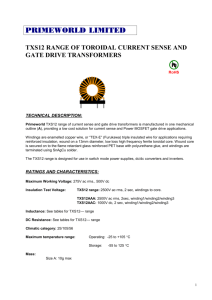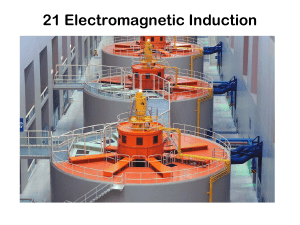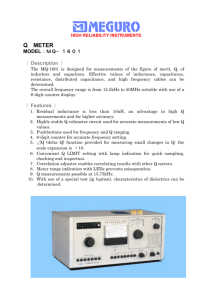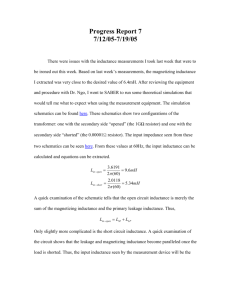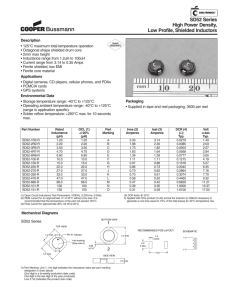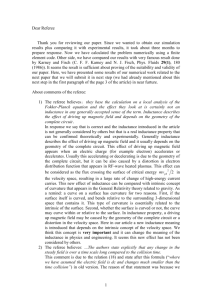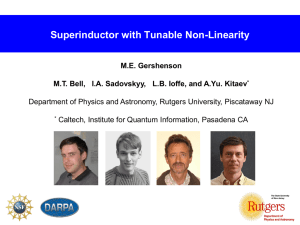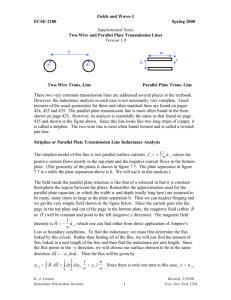doc
advertisement
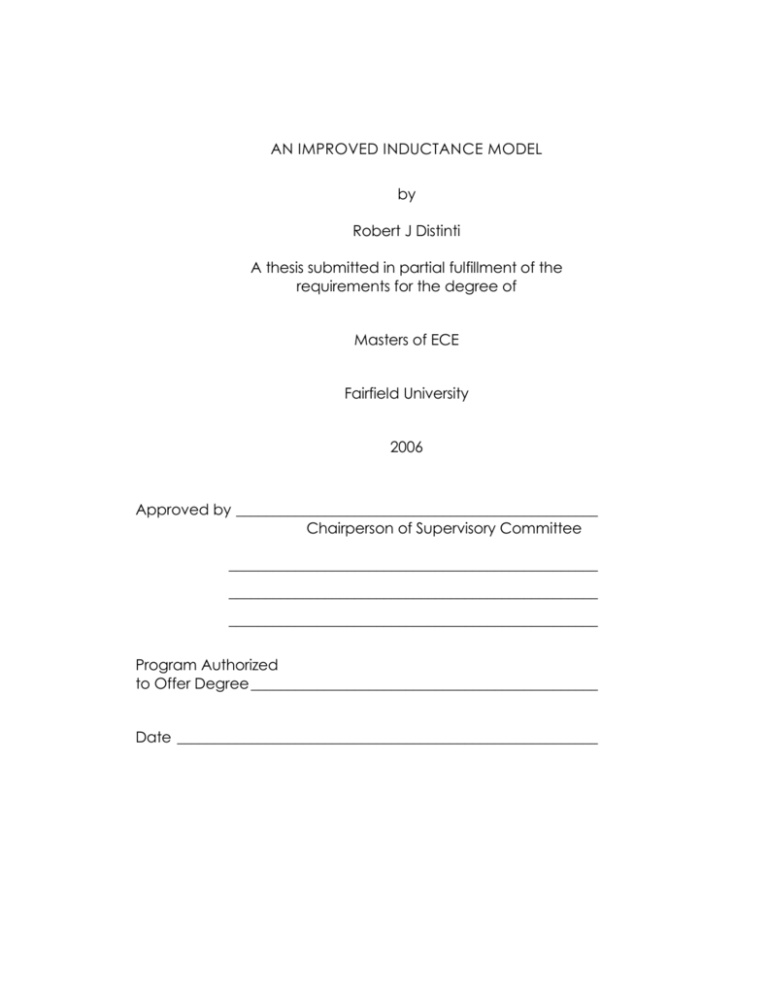
AN IMPROVED INDUCTANCE MODEL by Robert J Distinti A thesis submitted in partial fulfillment of the requirements for the degree of Masters of ECE Fairfield University 2006 Approved by _________________________________________________ Chairperson of Supervisory Committee __________________________________________________ __________________________________________________ __________________________________________________ Program Authorized to Offer Degree _______________________________________________ Date _________________________________________________________ FAIRFIELD UNIVERSITY ABSTRACT INDUCTANCE MODELING USING NEW ELECTROMAGNETISM by Robert J Distinti The inductive properties of circuits are modeled with a new model of electromagnetic physics Electromagnetism (NE) [ne_intro]. known as New The inductive properties modeled include self inductance, mutual inductance, intrinsic inductance and other effects coupled through a magnetic field. Accurate modeling of high-speed circuit properties is critical to developing reliable, efficient and cost-effective printed circuits and integrated circuits. Classical Electromagnetism (CE) performs well when modeling the property of mutual inductance; however, it is unsuitable for the other inductive properties mentioned above due to its reliance of continuous mathematics (to be explained). NE provides an order of magnitude improvement in both precision and computation time over CE due to the fact that it is a simple “line of sight” model for which complex field abstractions are unnecessary. 1. 2. 3. 4. 5. 6. 7. Table of contents Introduction ................................................................................... 5 Historical Review .......................................................................... 7 2.1. Self-inductance ........................ Error! Bookmark not defined. 2.2. Intrinsic inductance ................................................................. 18 New Electromagnetism ............................................................ 20 Application of New Electromagnetism ................................. 24 Validation .................................................................................... 28 Milestones .................................................................................... 29 Bibliography ................................................................................ 30 4 1. Introduction As the density and frequency of modern integrated circuits and printed circuits increase, the need for accurate modeling of circuit properties becomes imperative. The Inductance and capacitance of an integrated circuit(IC) trace is governed by its geometry, material as well as parasitic effects from other traces and ground planes. Any given trace could experience an unwanted resonance or “roll-off” that, under certain conditions, may lead to an intermittent failure. Capacitive and inductive coupling between traces is another source of intermittent failure. Accurate modeling of circuit properties prior to fabrication will reduce the number of development “re-spins” required to get a product through development and acceptance testing. Reduction of the number of development “re-spins” correlates to faster time to market, lower cost and improved reliability. Reducing “re-spins” further reduces the environmental impact and cost overhead associated with short engineering production runs. Eliminating the uncertainty and time associated with computer modeling of vast networks of signals allows computer tuning of individual traces; thereby eliminating the wasteful “one-size fits all,” “worst-case” termination methods. Utilizing this technique, device designers can reduce power consumption by using 5 existing geometries more efficiently. Reducing power consumption reduces the energy cost to the user as well as reducing the environmental impact associated with the use of energy. This research addresses a new, more accurate model of circuit properties associated with magnetic fields. include self-inductance, These properties mutual-inductance inductance. 6 and intrinsic 2. Historical Review In classical theory, the inductance of a trace is the combination of the self-inductance, intrinsic inductance (internal inductance) and the mutual inductive coupling between other traces (which includes ground plane). The properties of Mutual and Self-inductance are modeled using Faraday’s law or derivatives of Faraday’s Law based on Vector magnetic potentials. Of these derivatives, there are two from which all others are derived: one is Neumann’s equation [Lorraine] and the other is called Partial inductance [Ruehli]. Lastly, the property of intrinsic inductance [Hayt] is developed using a conservation of energy approach. Because classical theory performs well on mutual inductance, this historical review focuses primarily on self-inductance and intrinsic-inductance. 2.1. Faraday’s law The most basic Self-inductance problem is the single turn loop inductor as shown in Figure 1. Classical Theory teaches that the self-inductance of this loop is determined by Faraday’s Law (1), and the Biot-Savart flux model (3) [see Hayt]. 7 W I S=perimeter A=Area Figure 1 1) emf n d dt 2) emf L dI dt 3) dB K M IdS rˆ r2 In the above equations, is the number of flux lines contained in (or linked by) the loop; n is the number of turns in the loop; emf is the voltage induced in the loop as a function of flux change; I is the current in the loop. L is the inductance in the loop; K M is ; 4 B is the flux density (Webbers per square meter); r is the distance from a differential segment of wire to the point where the flux density is being determined. Substituting (2) into (1) and reducing (n=1) yields (4) 8 4) L I To find we integrate (3) over the area circumscribed by the loop to arrive at: 5) ( I ) dBdA K M AS AS IdS rˆ dA r2 This resolves to 6) (I ) thus L The above results are obviously useless; a typical reaction to this result is to assume that the modeling of an inductor as a filament is the reason why the inductance goes to infinity. This is wrong for two reasons. First, the diameter of the filament is not parameterized; as such, there is no opportunity to “divide by a zero diameter”. Second, this filamentary model gives very accurate answers for mutual inductance problems. This model works well for mutual inductance because the distance (r) from the primary to the area circumscribed by the secondary does not go to zero. This occurs because the primary and secondary have a non-zero distance between them. 9 2.2. The Neumann Equation Another variation of Faraday’s Law is called the Neumann equation (7) [Lorraine, Ruehli] which is derived from Faraday’s Law using Vector Magnetic Potentials. dP dS r S P 7) M K M The Neumann equation is expressed in terms of the mutual inductive coupling between a primary and secondary loop as shown in Figure 2. P=primary r=distance between differential lengths dP and dS. dP I r dS W=radius A=Area S=secondary D=distance between loops Figure 2 Parallel Loops The Neumann equation (like Faraday’s Law) yields an undefined answer when applied to self-inductance modeling (P and S same loop). This is obvious since r would go to zero if d goes to zero. 10 This does not seem to concern anyone since the Neumann equation has become the basis for the predominant SelfInductance model called Partial Inductance [Ruehli]. 2.3. Partial Inductance Partial Inductance [Ruehli] divides a solid conductor into many “current chunks” (da*dl), then uses the Neumann equation to calculate the coupling between each chunk with the approximation that the current is a filament down the center of the chunk (center of da) moving in parallel to dl. The result is the “Partial Mutual Inductance” equation (8). 8) LPkm K M 1 a K aM cK cM aK aM bK bM dlK dlM daK daM rKM The specialized form of (8) for self-induction, known as the “Partial Self Induction” model is given as (9). 9) LPij 1 KM 2 2 T W li l j ai a j 0 0 dli dl j rij dai da j 11 W=width of rectangular conductor T=height dli dl j dai da j L=length rij Figure 3 It should be plain to see that if the integral is resolved, then rij goes to zero as the limit of da goes to zero yielding infinite inductance, yet again. There are dozens of papers that utilize the above models in some form or another, for which reasonably good results are reported; how can this be? The answer is actually quite surprising; these papers report that the results were obtained from numerical algorithms based on the models. This is ludicrous, because if the continuous model does not converge, then neither should the numerical equivalent. It is clear that if DeltaA (numerical equivalent of da ) is chosen to be large, then a very small result is obtained from the algorithm; consequently, if DeltaA is chosen very small, a large output is obtained; therefore, because of this non-convergent numerical model, values of DeltaA could be 12 selected such that the numerical output will match any desired result. Essentially, if the continuous models were well behaved, then the numerical models developed from them will be well behaved. In a well-behaved numerical model, reducing a “delta” value would normally cause the numerical integration to converge (less round-off error) to the value obtained from the continuous model. Alternatively, a numerical algorithm developed from a poorly behaved continuous model that converges on infinity will “explode” as the size of the “delta” is reduced; therefore, any reports of “good results” from these algorithms can not be taken seriously. 2.4. A Fine Mesh Another serious problem with the partial Inductance model is the time spent resolving inductance meshes. Each current “chunk” represents an inductor in a mesh were the mutual inductance among the “chunks” is determined with the Partial Inductance model. There are entire articles [(&&&) need reference here} devoted to the problem of reducing these very large mutual inductance matrices into a single inductance value using various techniques. Aside from the complexity, an assumption made by the Partial Inductance model is that current only travels along the length of the “chunks.” There is no provision to account for orthogonal 13 (radial) current displacement. Such displacements do occur, resulting in skin effects at high frequencies. The New Induction model eliminates all of the complexity and assumptions since all charge behavior is reduced to a “force per charge” field over the volume of the conductor. The inductance is then found by finding the path of least work between the terminals of the device under test. Because a complete force matrix is produced, all charge motion and behavior can be studied. 2.5. The Continuous Current distribution Classical models do not work for self-inductance problems because they are based upon the concept of a continuous current distribution; as such, the distance between the differential current elements limit to zero resulting in an undefined answer in all cases. Conversely, excellent results are obtained in the mutual inductance case simply because the primary and secondary current distributions are separate; therefore, the distance between the current elements is never zero. Furthermore, the approximation of a charge carrying conductor as a continuous distribution is sufficiently accurate. 14 The solution to the problem is to realize that current is not continuous, it is a corpuscular entity comprised of individual charges; therefore, electromagnetic models which are compatible with corpuscular (or discrete) systems of charges are required. A later section introduces New Electromagnetism (NE) which is ideal for this task. 2.6. The closed path Fallacy Another problem with classical theory is the concept that a closed path is required to calculate inductance. Partial Inductance [Ruehli] supposedly deals with this problem by theoretically closing loops at infinity; however, a simple thought experiment can show that a closed loop should not be required in order to calculate inductance. In this thought experiment, we suppose that there are only two charges inhabiting the universe; classical theory enables us to deterministically calculate the electromagnetic interactions based on charge position and velocity; but what about acceleration, which is the case of induction (di/dt)? If one charge accelerates, it will generate a changing magnetic field that should affect the other charge. According to classical theory and Partial Inductance, the charge needs to be part of a closed path in order to determine the direction and magnitude of the force affecting it. This is patently ridiculous since (according to Partial Inductance) it is possible to choose any 15 arbitrary path; resulting in an arbitrary, non-deterministic, solution. Therefore, the classical models are ambiguous. There must be a fundamental point charge equation that deterministically expresses the effect of charge acceleration between charges. I propose the New Induction model found in a later section wherein New Electromagnetism is introduced. 2.7. Another Valiant Attempt using Classical Theory Another valiant attempt at trying to solve self induction using continuous current distributions is found in the text Classical Electrodynamics by John David Jackson [Jackson]. The derivation that starts on page 181 yields the following answer to the self-inductance problem 8a 7 L 0 a ln b 4 b a Figure 4 With careful analysis of the derivation, it is shown [ind_jackson] that the derivation is not the self-inductance of a loop; rather, it is the mutual inductance between two loops as show in Figure 5. 16 Red target filament at periphery of toroid a b Blue source filament at center of toroid Figure 5 This is sensible because classical induction models are only valid for mutual inductance cases. 2.8. Alarm Bells The above derivation uses Vector Magnetic Potentials and Green’s theorem to compute self induction. Vector Magnetic Potential is just an abstraction of the Biot-Savart model and Greens Theorem is simply a method whereby the total flux linked by a closed loop can be found from a Vector Magnetic Potential. Therefore, these techniques are mathematically identical to using the Biot-Savart model and Faraday’s law to find self induction. If it is not possible to develop a sensible (non-undefined) answer to self induction using the basic models (Faraday’s Law, BiotSavart), then it is certainly not possible to develop a sensible answer to the induction problem using abstractions of those basic models (Green’s Theorem, Vector Magnetic Potentials). A solution developed from abstracted techniques should have set 17 off alarm bells years ago; but it didn’t. Why? The above result would be analogous to stating that a certain problem can not be solved using Coulomb’s Law; however, it can be solved using electric potentials. This is ridiculous because electric potentials are derived from Coulomb’s law and are thus limited to what Coulomb’s law can solve; likewise, Vector Magnetic Potentials are derived from Biot-Savart and therefore should not be able to solve anything more than what is possible using Biot-Savart. 2.9. Intrinsic inductance Intrinsic inductance is the inductance of the wire itself. By definition [Hayt], the inductance of an inductor is the sum of the self-inductance (calculated from faraday’s law or a related technique) plus the intrinsic inductance. Since there is no way to solve this intrinsic inductance property from classical field equations, a “backdoor” conservation of energy technique is often used [Hayt]. The resulting equation is (H/m) which 8 shows intrinsic inductance to be a function of wire length and not of thickness; however, a simple experiment teaches us that this is not the case. The following table shows the measured inductance of two single turn loops of same diameter but slightly different wire thickness. According to classical theory, these results should be the same; but they are not. 48 inch perimeter Measured loops inductance 18 22 AWG wire 26 AWG wire nH 2055 2655 Furthermore, none of the self inductance techniques reviewed, which profess “good results”, use this “intrinsic inductance” effect as part of their solution (although Ruehli does mention it; it is not used). 2.10. Wrap up of Historical Review Over [n (&&&)TBF (you have to cite all the articles that you reviewed)articles were reviewed in preparation of this work]; all (except a few based empirical modeling) used one of the above techniques in some fashion or another for modeling of self-inductance, only those papers directly referenced are found in the references section; the remainder are included by IEEE article number and placed into groups after the bibliography. 19 3. New Electromagnetism Before delving into the methodology used to determine inductive properties; it is important to highlight the fundamental field models that will be used in that endeavor. As Stated in the previous section, needed are Electromagnetic models suitable for discrete modeling. New Electromagnetism provides such a set of models The Equation F 2 K M QSQ T r F Coulomb’s Model K E QS QT rˆ r F Name 2 v T rˆ v S v S rˆ v S ( v S v T )rˆ K M QS QT a S New Magnetism New Induction r Where: K M 1 , KE 4 4 These equations represent the Force affecting a “target” charge due to the behavior and position of a “source” charge. The ‘S’ and ‘T’ subscripts in the above equations delineate properties 20 associated with the source and target charges. The vector r represents the vector from source to target in all equations. QS aS r vS F vT QT Figure 6: Two Body Diagram The first model is Coulomb’s model which relates force to charge position. Other than notational differences, it is identical to classical theory. The second model is New Magnetism. New Magnetism relates force to charge velocities. The first and third terms inside the brackets are derived directly from F QvxB and the Biot-Savart model. The middle term is required to make the model match well known experiments [secrets]. The third model is New Induction which was found through computer search of experimental data. New Induction shows that an accelerating source charge creates a disturbance that 21 expands spherically from the source which forces charges in the opposite direction. Both New Induction and New magnetism are based on a spherical magnetic field model. The magnetic field of classical theory, as described by the Biot-Savart model, is a “donut” or torrid shaped field because it does not provide for a magnetic field longitudinally to a moving charge (see Figure 7); therefore, New Electromagnetism is not a reformation of classical theory; it is a superset. QT r F vS aS Biot-Savart QS New Magnetism New Induction Figure 7 New Electromagnetism is ideally suited for modeling Self inductance and intrinsic-inductance simply because the models reflect the electromagnetic interactions charges. 22 among discrete Furthermore, the spherical field models of New Electromagnetism are a more complete expression of electromagnetic interactions enabling accurate solutions to physical systems that are as yet unexplained by classical theory ( homopolor paradox [nm], self induction) etc. Lastly, the spherical field shapes are vastly easier to process; thereby, reducing processing time and code complexity. 23 4. Application of New Electromagnetism Since New Electromagnetism enables us to model a problem as a systems of discrete charges; that is in fact the approach that is taken. The first, and most important task, is to establish a model for the relative spacing between charges. Since only mobile carriers are of interest, we develop a relationship for mobile carrier density from published material properties. The values in the following table are taken from Hayt [Hayt] page 133 and appendix C.2. Material Charge Mobility m2 e Vs Copper 0.0032 Aluminum 0.0012 Silver 0.0056 Conductivity 1 m Charge Density Q e m3 5.80x107 3.82x107 6.17x107 1.8125x1010 3.1833x1010 1.102x1010 From the above table it is apparent that copper has 18 billion Coulombs of mobile carriers per cubic meter. This works out to 18 Coulombs of mobile carriers per cubic mm. At first glance it might seem like an insurmountable task to model conductor properties at the charge level; however, the task is vastly simplified by use of a technique that shall be called “seeding” for lack of a better term. 4.1. The Seeding Technique The seeding technique begins with a single charge. Then the inductive contributions from that charges nearest 10n neighbors (this value is selectable) are calculated as shown in the following diagram. 24 Radius R Figure 8: The seed for a given metal The neighbors are chosen to form a spherical template of radius R. The number of neighbors is chosen such that R is sufficiently large such that the charge in the remaining parts of the conductor can be accounted for using continuous charge techniques. The seed value for each given metal only ever needs to be computed once. The seed is then reused for all processing using the seed growing method shown in the next section. Seeds are needed for boundary conditions as well. Boundaries include the sides of the conductors (Hemispherical seed) and other boundary conditions which include those of dissimilar metals such as solder or plating. 25 4.2. The Seed Growing Method The seed is placed at a point in a metallic structure where the inductive force is to be determined. Then spherical shells are added to the system as shown Cylindrical conductor (side view) Outer shells The seed Figure 9: Seed growing (not to scale) The thickness of the shells can become progressively larger depending upon the inverse relationship of the effect being modeled. The purpose of the shell is to reduce the problem to a point charge equation where the total charge affecting the charge at the center of the seed is the charge density times the volume of the shell intersecting the wire construct. The distance is a function of the inner and outer radius of the shell. The seeds are grown a various strategic points within the wire and at boundaries in order to map out the patterns of force. 26 4.3. Two courses of Action The development can go two different ways depending upon how things work out. The first assumes that the current distribution remains substantially constant, as such the voltage and current through the wire is essentially uniform. This case will enable full use of the seeding method as is. The draw back is that this technique is only applicable for systems where the highest frequency component being modeled has a far larger wavelength than the dimensions of the circuit. Thus this technique is only applicable to systems of mid to low frequency [this may be enough to validate the thesis]. The second initiative allows for retarded time modeling of field effects. This modeling requires complex computational data structures which save representative current distributions and voltages at the seed points such that constructive and destructive interference can be accounted for when modeling high frequency signals 27 5. Validation Validation consists of achieving better than 0.5 % tolerance with measured data. At this point I have not decided whether to use published tables of measured values or measure my own. – this is part of the timeline decision making process. [ not 100% sure yet] 28 6. Milestones [see Microsoft project application that accompanies this document] 29 7. Bibliography References to New Electromagnetism [NE_intro] Distinti, Robert J., 2005. New Electromagnetism Introduction. www.distinti.com/docs/ne_intro.pdf [NI] Distinti, Robert J., www.distinti.com/docs/ni.pdf 1997. New Induction, [NM] Distinti, Robert J., 2001. New Magnetism, Area-46 Publishing, Fairfield, CT. www.distinti.com/docs/bk_000.pdf. [Secrets] Distinti, Robert J., 2004. The Secrets www.distinti.com/docs/the_secrets_of_qvxb.pdf of QvxB, [ind_jackson] Distinti, Robert J., 2004. A classical Attempt at Induction, www.distinti.com/docs/ind_jackson.pdf. [ni_neumann] Distinti, Robert J., 2003. New Induction and the Neumann Equation, www.distinti.com/docs/ni_neumann.pdf References to general classical theory texts [Jackson] Jackson, John David, 1999. Classical Electrodynamics, Third Edition. John Wiley and Sons Inc., Hoboken, NJ. On page 181 is found a solution to a current ring using Vector Magnetic Potentials. [Hayt] Hayt, Wiiliam H., 1981. Engineering Electromagnetics, Fourth Edition. McGraw-Hill Inc., New York. [Lorraine] Lorrain, Paul, 1988. Electromagnetic Fields and waves, Fourth Edition. W.H. Freeman and Company, New York. References to papers proposing Inductive modeling techniques 30 [Ruehli] A. E. Ruehli, Inductance Calculations in a Complex Integrated Circuit Environment, IBM Thomas J. Watson Research Center, Yorktown Heights, New York. [Schanen] Schanen, Jean-Luc et al., 1994. Modeling of Printed Circuit Board Loop Inductance, IEEE Transactions on Magnetics, Vol. 30, No. 5. [00312715#6] References to useful techniques or measured data [fft] Hu, Haitian et al., 2003. ,Fast On-Chip Inductance Simulation Using a Precorrected-FFT Method, IEEE Transactions on Computer Aided Design of Integrated Circuits and Systems, Vol. 22, No. 1. [01158253#4] Reviewed papers that are not referenced [00622203#1] T.Nakazato et al., Inductance Computation of Microscopic Superconducting Loop, IEEE Transactions on Computer Aided Design of Integrated Circuits and Systems, Vol. 22, No. 1. [00466178#2] Cherry, Paul C. et al., 1995. FDTD Analysis of High Frequency Interconnect effects, IEEE Transactions on microwave theory And Techniques, Vol. 43, No. 10. [00783917#3] Zhang, Yongming, 1999. Modeling os a Long Josphson Junction Coupled to SFQ Elements, IEEE Transactions on Applied Superconductivity, Vol. 9, No. 2. [00037205#5] Poltz, J. et al., 1989. Cross-Talk and Ringing on a Multilayer PCB. IEEE National Symposium of Electromagnetic Compatabillity, Denver, C). 23-25 May 1989. [00346626#8] Griese, E. et al. (no year), Fast Simulation of Reflection and CrossTalk Effects Using Pade Approximation, IEE Electromagnetic Compatibility Conference, 5-7 September. 31 [00385661#9] Hubbing, Todd H. et al., 1994. Identifying and Quantifying Printed Circuit Trace Inductance, University of Missouri-Rolla. [00473718#10] Leferink, Frank B. et al., 1993. Inductance of Printed Circuit Ground Planes, IEEE (no other info given) [00569518#11] Holloway, Christopher L., et al., 1998. Net and Partial Inductance of a Microstrip Ground Plane, IEEE transactions on Electromagnetic Compatibility, Vol. 40, No. 1. [00678798#12] Swirbel, Tom, et al., 1998. Electrical Design and Simulation of High Density Printed Circuit Boards. IEEE Electronics Components and Technology Conference 1998. [00892842#13] Tang et al., 2000. Characterization of Coreless Printed Circuits Boards (PCB) transformers, IEEE Transactions On Power Electronics, Vol. 15, No. 6. [00974648#14 Leone, Marco, 2001. Design Expressions for the Trace-to_Edge Common-Mode Inductance of a Printed Circuit Board. IEEE Transactions on Electromagnetic Compatibility, Vol. 43, No. 4. [00982839#15 Sohn, Young-Soo, et al. 2001. Empirical Equations on Electrical Parameters of Coupled Microstrip Lines for Crosstalk Estimation in Printed Circuit Board. IEEE Transactions on Advanced Packaging, Vol. 24, No. 4. [01057897#16] Miller, Jason R, et al., 2002. Calculating Partial Inductance of Vias for Printed Circuit Boards Modeling, IEEE 2002. [01280307#17] Chen, Yang, et al., 2003. Analysis and Measurement of Small Inductance of Loops and Vias on Printed Circuit Board. IEEE 2003. 32 [01287848#18] Charyulu et al., 2003. Analysis and Measurement of Crosstalk in Printed Circuit Board de to RF and Transient Pulses. Proceedings of INCEMIC -2003. [01296122#19] Lopez, Toni, et al., 2004. PCB Layout Inductance Modeling Based on a Time Domain Measurement Approach. IEEE 2004. [00290725#20] Witulski, Aurther F., 1993. Modeling and Design of Transformers and Coupled Inductors. IEEE 1993. [00299741#21] Geiwski, W. et al., 1994. Hybrid Inductor Modeling for Succesful Fileter Design. IEEE Transactions of Microwave Theory and Techniques, Vol. 42, No. 7. Followup references: H.M. Greenhouse Design of planar rectangular microelectronic inductors IEEE trans. Parts, hybrids, packaging, vol PHP-10 pp101-109 june 1974 33 INDEX 34 A Aristotle,3 4
